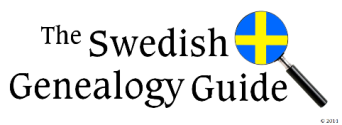One of the biggest challenges that people face in Swedish genealogy is the language. Rather than get discouraged, here are some tips to consider:
Start by learning key words. Most of the time you will be searching the parish records, so focus on learning the key words for the birth, marriage, and death records.
As most household examination records are organized by place, learn how to read the place names. Use gazetteers to help identify a place name that is difficult to interpret (see the gazetteers listed in the links list.)
The Swedish household examination records are known for the comments that were written out to the side of a person’s name. The comment may, or may not be important but you won’t know the value until you find out what it means. The comments are usually written as sentences which use a wider variety of the language. They were written in a form of the spoken language.
The spelling of words was standardized over time. The earliest attempt of spelling reform was in 1801. They tried again in 1869 and between 1886 and 1899. The biggest changes to spelling took place in 1906 (see Gammalstavning in the Swedish Wikipedia)
All languages evolve over time. You’ll find that some words had different meanings in the past; some words have been added to the language, while others words have disappeared completely. To help with this problem, you can use Swedish – English dictionaries that were printed in the time period that you are researching. The easiest one to use is the Swedish Historical Dictionary Database, or SHDD. It’s a free searchable database built upon a Swedish – English dictionary printed in 1814. Other historical Swedish – English dictionaries are available for free through Google books and other websites. Here is a list by year, author, and title:
1788. Widegren, Gustaf. Svenskt och Engelskt Lexicon (pdf)
1814, Wahrman, S. N. Svenskt och Tyskt, Franskt, Engelskt Hand Lexicon (Searchable through the Swedish Historical Dictionary Database, or SHDD)
1829. Deleen, Carl. Swedish and English Pocket Dictionary (pdf)
1872. Öman, V.E. Svensk-Engelsk Hand-Ordbok (pdf)
1889. Björkman, Carl Gustaf. Svensk engelsk ordbok (pdf)
Most of the dictionaries can be downloaded as a PDF (click on the titles to download). In some cases the dictionary can be printed “on demand” such as the Widegren dictionary from 1788 through booksellers such as AbeBooks or Amazon.
I bought a “print on demand” copy of the 1788 Widegren dictionary and this is what I found. This dictionary was printed in a Romanized font instead of the Gothic font. This makes the dictionary a lot easier to read. Most of the text printed just fine, but many letters are missing part of a letter, for example the lower part of the letter a, k or g. The diacritic marks above the Swedish letters Å, Ä, and Ö are partially printed or missing too. Another challenge is the English words were printed in old English where they used a long “s” that looks like a lower case f instead of a lower case s, such as eftablifh. Nonetheless the 1788 Widegren dictionary offers unique historical insight to the language of that time period.
You can learn a lot about the Swedish language and genealogy by reading the Language Characteristics section of the Swedish Genealogical Word List on FamilySearch.org.
You can also get help with the language from a variety of Swedish genealogy forums online. See the Forums (for Questions and Answers) section of our Links page.
Best wishes in the journey to find your Swedish ancestors.
Geoff
